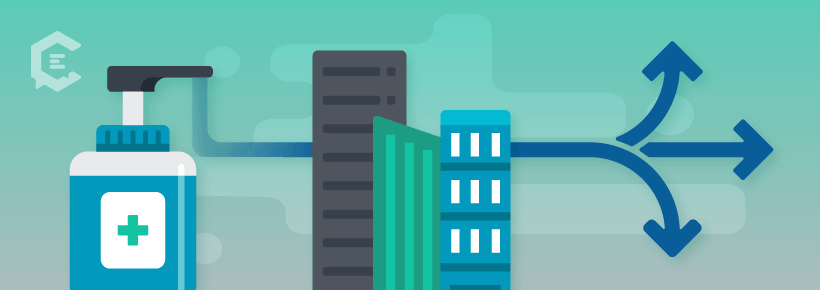We’ve all been there; you’ve researched, planned, predicted, created and implemented a content plan so brilliant and robust that it’s sure to dazzle even the toughest crowd. Your launch day finally arrives and you roll out your brilliant content. Just as anticipated, the crowds go wild and can’t wait for more! You’re a huge success and can’t wait to rest on your laurels.
In fact, every element of your content plan worked out exactly the way you hoped it would… until a crisis hits. Now you have to scrap all your initial plans, start all over again and figure out what happens next.
While most of us have had that moment where we go from amazing to deflated in no time flat, it’s a safe bet to say none of us have had to shift things completely due to an international pandemic before. And suddenly we’re all in a state of limbo trying to figure out how to keep our businesses afloat while continuing to produce content worthy of this brave new world.
Use this content contingency plan to adjust messaging in a crisis
If it’s possible to glean a lesson in all of this uncertainty, it’s this — you’re not the only one having to shift everything and start from scratch. And similar to the dawn of the internet before big-budget businesses joined the scrum, that means that we’re all in the same boat and have to learn to navigate this new landscape.
And, just like you, even the most established and well-funded businesses will have to redirect messaging/content/campaigns due to impacts of the coronavirus. Some campaigns might be halted, others might be overhauled, while entirely new content campaigns likely will need to be created to address the evolving situation.
Be gentle (with yourself and your clients).
Some of the most iconic brands have acknowledged the changed state of the world right now by supporting messaging of staying home and self-isolating. They also managed to add a gentle bit of humor to their immediately updated logos. Adweek reported that Chiquita and Coke created a soft approach using their brands to encourage staying home to curb the spread of the coronavirus.
- Chiquita posted a sparer version of its logo. Noticeably missing was Miss Chiquita, who tweeted in absentia, “I’m already home. Please do the same and protect yourself.”
- Coca-Cola went big and then went home with a giant billboard in Times Square featuring a version of the Coca-Cola logo with the letters spread out instead of closely kerned. The copy on the ad read, “Staying apart is the best way to stay united.”
- In another moment of sheer marketing magic (and also reported in Adweek), Agency Activista recreated iconic album covers ranging from The Beatles’ “Abbey Road” to U2’s “The Joshua Tree” — the formerly crowded photographs now featured plenty of room between band members.
3 things to try immediately:
If you’re too impatient to wait it out and feel that you have to make a statement or change your content plan immediately, here are a few immediate ideas.
1. Create content that acknowledges the zeitgeist, confusion and all.
It’s okay to come across as unsure. What’s not okay is to drop the ball entirely. If you haven’t created the perfect content package, that’s fine. Just figure out how to speak from the heart and let your clients, readers and partners know what’s going on.
2. Ask for help.
If your sister company or partner agency is brilliant with graphics, while your team is still finding your way, now is the time to consider joining in a shared approach. It’s fine if it’s a little sloppy or doesn’t represent your shared vision fully either. Who knows? Maybe next year at this time you’ll both be sharing a timeline of how your companies came together in a time of crisis.
3. Lend an ear.
One of the biggest things you might be able to do for your clients or advertisers is to simply be there listening. “We want our customers to know our phone lines are open and we’re here for them beyond technical support,” shared Steve Bujouves, VP Support at FreshBooks.
“This is a tough time right now for everyone, and we’re here if they just need someone to talk to. Our phones are open.” You don’t have to provide all the answers, you just have to remind them that you’re still there.
Be flexible.
Some global brands made huge strides immediately and proved that while their core business isn’t thriving, they still serve their client base and will continue to do so through the worst of it.
- Diageo, maker of Johnnie Walker and Smirnoff, pledged to provide Grain Neutral Spirit (GNS) – a 96 percent strength ethyl alcohol used primarily in the production of vodka and gin to be used in the production of hand sanitizers.
- And fashion and beauty powerhouse LVMH* announced that its perfume and makeup factories would now be committed to making hand sanitizer to donate to hospitals in Paris.
Yes, these brands will be losing millions over the coming weeks and months; they’re also doing the right thing for humanity, so there’s that. For smaller brands, there’s more urgency to figure out how not only to take part in the conversation happening on the world stage, but to simultaneously reassure clients that you’re going to weather this storm together.
Remind clients you’re accessible.
Now isn’t the time for coyness. “This pandemic is something that almost no one has ever experienced and the old rules may not apply,” said Sacha Cohen, Founder of Grassfed Media, who specializes in the hospitality industry.
“Most of my clients are small businesses and they have never faced a crisis of this magnitude before. Even the ones who were around during 9/11 don’t know how they will make it through this.” For that reason, Cohen has been reaching out to her clients to, among other things, “discuss communications strategy and to share my thoughts on communicating with their clients and community.”
She took a multi-prong approach through email, social media and her company blog. While her messaging was tailored to each client’s specific needs, Cohen said she was consistent in one recommendation:
“Be flexible in terms of quickly changing what and how you communicate, be transparent, be empathetic, be honest, and think about the big picture and the impact that this is going to have not only on your business but on your customers, suppliers, and other stakeholders.”
Connect and then reconnect with your team.
Keep reassuring your employees. Explain to them how changes in your structure will impact them. Let them know what work will be expected of them and how having a fully mobile workforce will change the way you interact.
Expand your freelance and while you’re at it, this would be a great time to take on freelancers and assemble your own team of pinch hitters who can brainstorm or create content if you need to expand your content production or if key members need to take time off.
You might be inspired by the ClearVoice Talent Network, which has a robust team of freelancers who are used to working with a variety of clients on everything ranging from blog posts and articles to white papers. Best yet, they’re used to not only a learning curve with each client but will also work with you to figure out how to pivot your content for whatever comes next. (Here’s one of my favorite profiles in the network.)
Self-promotional moment aside, now is a great time to reconfigure your SWOT analysis and spend some time figuring out if your company’s strengths, weaknesses, opportunities and threats are the same as they were pre-pandemic.
Encourage your network to rely on you.
Throughout 13 seasons of the Canadian TV show ‘Heartland,’ there’s been one character who everyone else relies on no matter what. Grampa or GG or just plain Jack Bartlett, played by veteran actor Shaun Johnston, is a weathered former rodeo cowboy who holds his family and the Heartland ranch together through good times and bad. He’s wise without being preachy and can always be counted on for a hug, advice, or simply to remind everyone else what’s important in life.
Life is scary right now and the future of work can feel a bit overwhelming. And I, for one, think we all need a proverbial Jack Bartlett in our own lives.
It’s a good idea to show employees, colleagues and clients that you’re the one who will weather it all with them. And doing so proves not only that you’re good in an emergency, but that you intend to stick around for the long haul.
3 ways to show people you’re here for them
1. Go live.
Content creator and documentary photographer Willow Paule, recently did a Facebook Live presentation on outsourcing. She explained that she “decided to do the Facebook Live because I think some small business owners and creatives feel confused about what outsourcing entails. They are afraid they will have to spend too much time describing their vision, and assigning the projects, and that it will be too complicated to hand off the work. Or they are afraid that once they hand the work off, it won’t be prioritized or the contractor they work with will be flaky and not complete the job.”
While Paule acknowledges that these are valuable concerns, she explained the ways that while these are valid concerns, if people get clear on their goals in outsourcing, “the benefits outweigh the risk.” Consider testing out Facebook Live as a way to immediately connect with people you’ve previously worked with or hope to attract.
2. Support others.
We’re all in the same boat right now, so supporting local businesses proves that you’re about more than the bottom line. Bujouves said, “We want to support local businesses near the FreshBooks offices in Toronto, Amsterdam, and Raleigh.”
To that end, they’ve set up a “Values Card program where FreshBookers send each other $25 gift cards to recognize each other for living out our FreshBooks company values.” Best yet, those gift cards are “going to start going to the local restaurants around our offices. This will help get funds into the hands of these local businesses today, in hopes they can be with us tomorrow.”
3. Create content people can use.
If you’re not sure what your own content plan will be moving forward, try creating something that others can use, share and quote from. For Freshbooks, that includes businesses. “We’ve put together a resource guide to help customers and small businesses get through the uncertainty around COVID-19,” Bujouves said.
In this way, the brand proves that they think beyond the next subscription and instead work to provide tools to help clients through tough times.
*Full disclosure, LVMH is a former client.








